Subcontracting Workbench
This chapter covers the following topics:
- Overview
- Viewing Subcontracting Orders
- Viewing Replenishment Orders
- Consumption Adjustments
- Processing Consumption Adjustments
Overview
The Subcontracting Workbench User Interface enables you to view subcontracting orders and replenishment orders and helps you take appropriate actions for better control of the subcontracting process. Use the workbench to:
-
View subcontracting orders
-
View replenishment information for components
-
Create manual shipment allocations
-
Adjust subcontracting component consumptions
Related Topics
Viewing Subcontracting Orders
On the Components page of the Workbench, you can search and view Subcontracting Orders by manufacturing partner, or by an assembly. If you are using Project Manufacturing, then you can also search and view the subcontracting orders by project.
These subcontracting orders are regular purchase orders and releases created for outsourced assemblies. You can view header details in the Workbench.
Subcontracting order lines contain details of the outsourced assembly ordered through the MP.
Details of the components required for manufacturing the outsourced assembly at the MP's site can be viewed on the shipment details page.
-
Navigate to the Subcontracting Workbench User Interface.
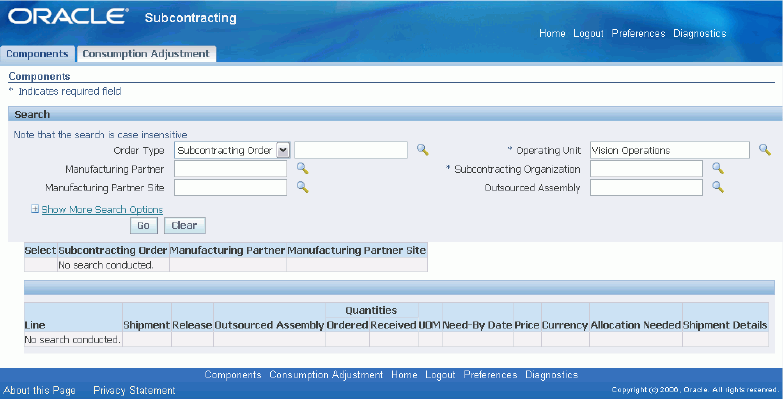
-
Select the Components tab.
-
Select the Subcontracting Order type from the list of values.
-
Enter an Operating Unit and Subcontracting Organization (required).
-
Enter additional search options as desired, and click Go.
Search parameters include:
-
Subcontracting Order and Order number, or Replenishment Order and Order number
-
Operating Unit
-
Subcontracting Organization
-
Outsourced Assembly
-
Subcontracting Order Date From and To
-
Manufacturing Partner
-
Manufacturing Partner Site
-
Purchase Order Status
-
Allocation Needed

-
-
Click the Shipment Details icon to navigate to the shipment details page. The Shipment Details page displays the components to be shipped by the OEM to the MP for manufacturing the assembly.
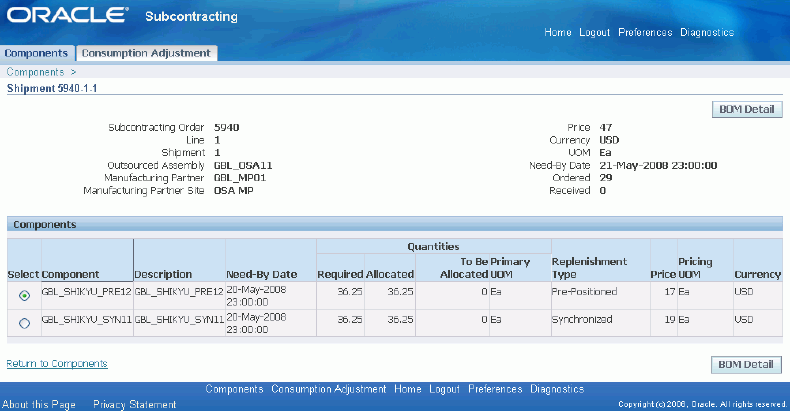
This page shows the details of component requirements and allocations for manufacturing the assembly and list price (sales price) of the components at the time of creating the subcontracting order.
-
Click BOM Detail to view the current BOM details of the outsourced assembly.
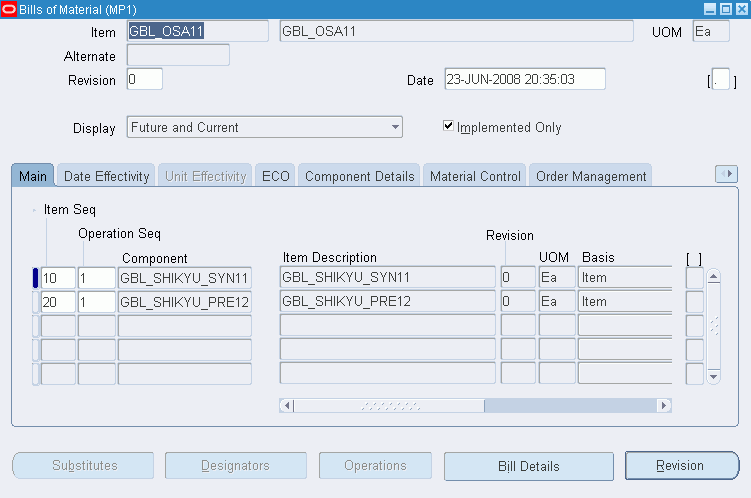
The Bills Of Material window appears and displays component details. This is useful for comparing the components with the current BOM components in case the components are different from the BOM due to revision change introduced after creating the subcontracting order. You must cancel the subcontracting order and then recreate a new subcontracting order and run the Reconciliation Manager and Interlock Manager. The new subcontracting order and components are created with the new BOM.
Viewing Replenishment Orders
On the Components page of the Workbench, you can search and view replenishment orders created in the OEM organization for shipping components to the MP. You can search for replenishment orders by MP, by component, and by project. On the Components page:
-
Search results display as replenishment order headers
-
When selecting a specific order, you can view the replenishment sales order lines for shipping the components. For synchronized components, the replenishment order is allocated to one subcontracting order for the outsourced assembly. For pre-positioned components, the replenishment order is generally allocated to multiple subcontracting orders.
-
Click Allocate Components to view and create allocations
The Subcontracting workbench lets you manually allocate shipments if necessary.
To view replenishment orders
-
Navigate to the Subcontracting Workbench User Interface.
-
Select the Replenishment Order type from the list of values.
-
Enter an Operating Unit and Subcontracting Organization (required).
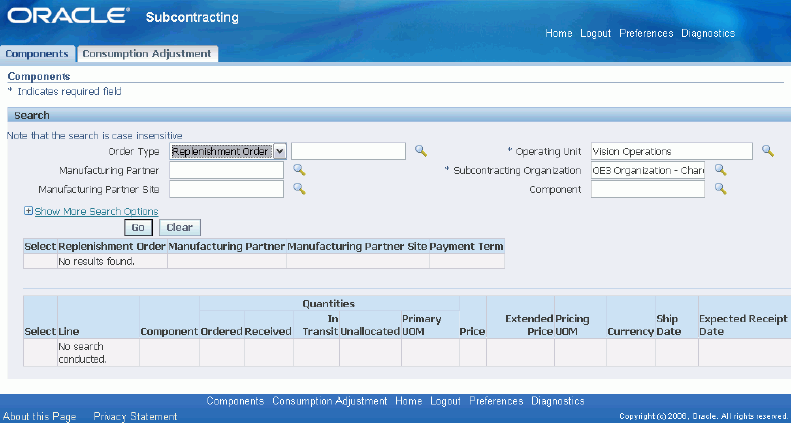
-
Enter additional search options as desired, and click Go. The Components page appears and displays a list of Replenishment Orders. The page also displays order lines for selected orders.

To view and create allocations
On the allocations page, you can view existing allocations that were created by Interlock Manager, and create allocations manually if required. For synchronized components, replenishment orders are always created for the required quantity of the discrete job associated to a subcontracting order. These replenishment orders are always fully allocated. For pre-positioned components, replenishment orders are created well ahead of requirements, and are allocated periodically. As a result, these orders can have unallocated quantities.
-
From the Components page, click Allocate Components. The Allocations page appears and displays allocation details for the selected order.
-
Select the Existing Allocations tab to view details of the subcontracting orders allocated to the current replenishment order.
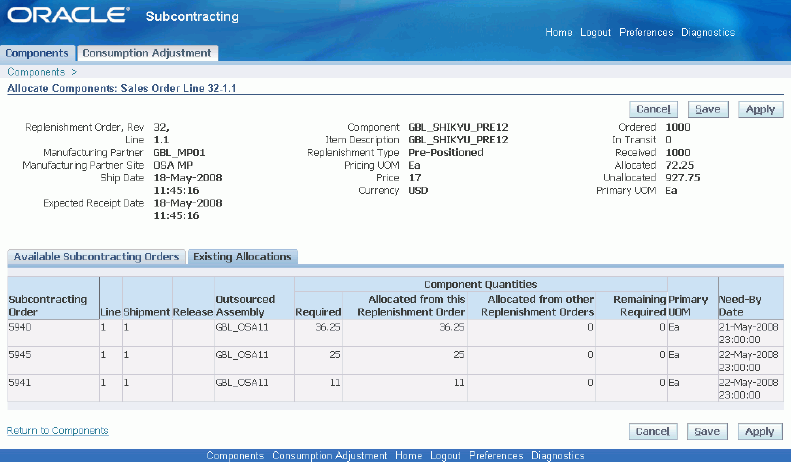
-
Select the Available Subcontracting Orders tab to display a list of subcontracting orders that require component allocations. For replenishment sales orders of pre-positioned components, there may be unallocated quantity. If pre-positioned components are not fully allocated, then you can manually allocated them in this page.

-
Enter the quantity to allocate in the Allocate column and click Apply.
Consumption Adjustments
Subcontracting orders are executed based on the planned component requirements as per the BOM of the outsourced assembly. It is assumed that the MP consumes the components based on the planned BOM component quantity and Yield, and the simulated inventory records of the MP organizations are processed accordingly. However, the MP might consume more or less components for manufacturing the assembly due to process variations, and the OEM must adjust the simulated records of the MP organization for proper inventory and financial accounting.
The MP sends a report of actual material usage at the period end, and the OEM verifies and adjusts the simulated records.
Use the Consumption Adjustments page to enter adjustments for the subcontracting component based on reports sent by the MP. You can search subcontracting order components by OEM organization, subcontracting order number, or component. Enter the actual consumption of the subcontracting order component at the manufacturer partner’s facility.
The component adjustments reported through the workbench are further processed by the Subcontracting Consumption Adjustment Manager concurrent request. It adjusts subcontracting components on-hand quantity in supplier organizations, and adjusts allocations between subcontracting replenishment orders and subcontracting orders.
To report consumption adjustments
-
Navigate to the Subcontracting Workbench.
-
Select Consumption Adjustment.
-
Select Subcontracting Order or Component (required).
Note: If the adjustment type is by Subcontracting Order, then input into the Purchase Order number is required. If adjustment type is by Component, then input into the Component is required.
-
Enter an Operating Unit and Subcontracting Organization (required).
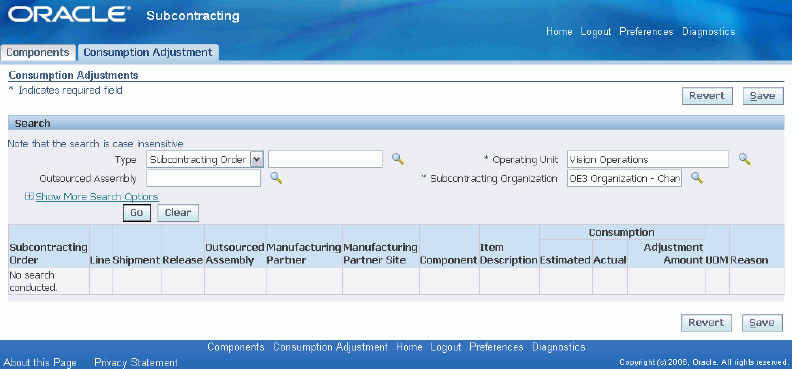
-
Enter additional search options as desired, and click Go. The Consumption Adjustments page appears and displays subcontracting order line details.
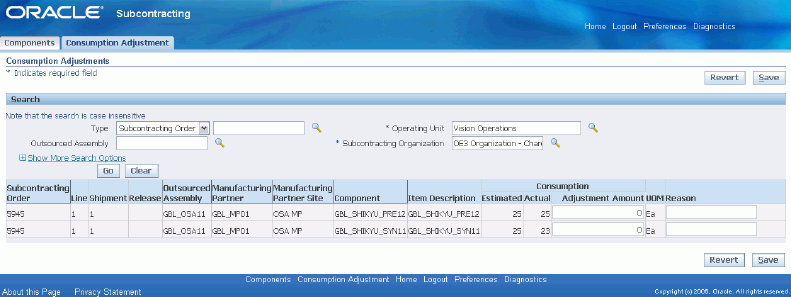
-
Enter the Adjustment Amount and a Reason for the adjustment.
-
Click Save.
Note: The application displays required quantity based on the BOM. Actual consumption will be the same as planned consumption. You must enter the variation in the consumption. If the consumption is more, then enter positive quantity in the adjustment amount indicating more consumption than planned quantity. If consumption is less, then enter quantity with a minus (-) sign, indicating that quantity consumed is less than the planned quantity.
Related Topics
Processing Consumption Adjustments
Processing Consumption Adjustments
The consumption adjustment processor processes adjustments entered on the workbench. Allocations are readjusted, and WIP component issues or WIP component returns are made to adjust the actual consumption of the simulated discrete job in the MP organization.
Processing Logic
This program picks up the positive and negative adjustments of the components entered on the workbench and process.
For positive component consumption adjustments, the program:
-
Creates WIP issues for the discrete job associated with the subcontracting order in the MP organization
-
Increases allocations for the subcontracting order
-
If there is not enough replenishment available,, then the program does not process those adjustments entered on the workbench. This scenario probably will not occur because adjustments are made at the end of a period, by which time the OEM would have sent enough material to the MP for this additional requirement. This scenario could occur if you enter only positive adjustments first. Therefore, we recommend that you do not process all of the adjustments (positive and negative) at one time.
For negative component consumption adjustments, the program:
-
Creates WIP returns for the discrete job associated with the subcontracting order in the MP organization
-
Decreases allocations for the subcontracting order
To process consumption adjustments
-
From the Subcontracting responsibility, navigate to the Subcontracting Requests window.
-
Select Subcontracting: Process Receiving Transactions from the Requests window and click OK. The Parameters window appears.

-
Enter an optional Batch Size. Valid characters are 0 through 9.
-
Optionally, enter a value for Maximum Workers. Valid characters are 0 through 9.
-
Click OK.
-
Click Submit to run the request.